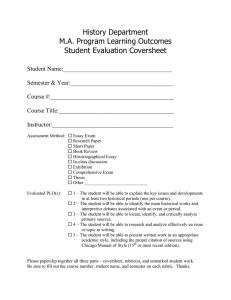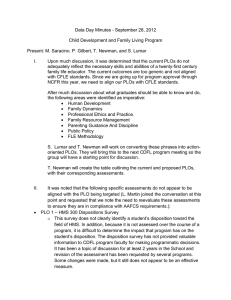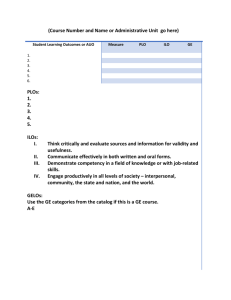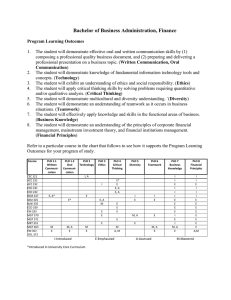Annual PLO Report
advertisement
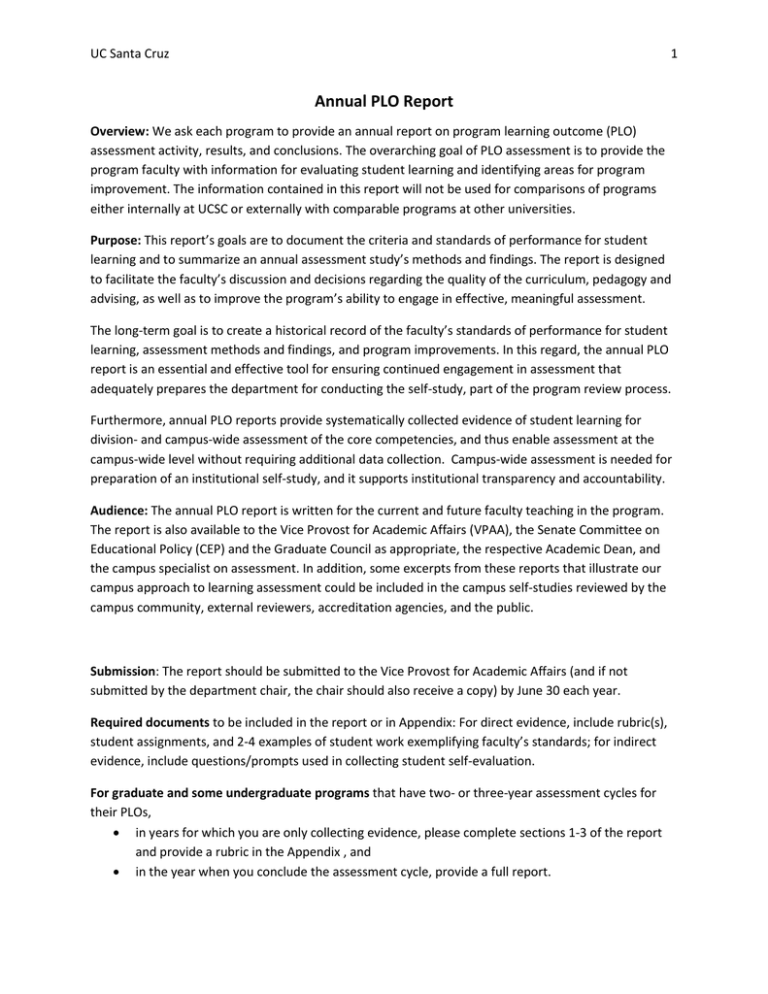
UC Santa Cruz 1 Annual PLO Report Overview: We ask each program to provide an annual report on program learning outcome (PLO) assessment activity, results, and conclusions. The overarching goal of PLO assessment is to provide the program faculty with information for evaluating student learning and identifying areas for program improvement. The information contained in this report will not be used for comparisons of programs either internally at UCSC or externally with comparable programs at other universities. Purpose: This report’s goals are to document the criteria and standards of performance for student learning and to summarize an annual assessment study’s methods and findings. The report is designed to facilitate the faculty’s discussion and decisions regarding the quality of the curriculum, pedagogy and advising, as well as to improve the program’s ability to engage in effective, meaningful assessment. The long-term goal is to create a historical record of the faculty’s standards of performance for student learning, assessment methods and findings, and program improvements. In this regard, the annual PLO report is an essential and effective tool for ensuring continued engagement in assessment that adequately prepares the department for conducting the self-study, part of the program review process. Furthermore, annual PLO reports provide systematically collected evidence of student learning for division- and campus-wide assessment of the core competencies, and thus enable assessment at the campus-wide level without requiring additional data collection. Campus-wide assessment is needed for preparation of an institutional self-study, and it supports institutional transparency and accountability. Audience: The annual PLO report is written for the current and future faculty teaching in the program. The report is also available to the Vice Provost for Academic Affairs (VPAA), the Senate Committee on Educational Policy (CEP) and the Graduate Council as appropriate, the respective Academic Dean, and the campus specialist on assessment. In addition, some excerpts from these reports that illustrate our campus approach to learning assessment could be included in the campus self-studies reviewed by the campus community, external reviewers, accreditation agencies, and the public. Submission: The report should be submitted to the Vice Provost for Academic Affairs (and if not submitted by the department chair, the chair should also receive a copy) by June 30 each year. Required documents to be included in the report or in Appendix: For direct evidence, include rubric(s), student assignments, and 2-4 examples of student work exemplifying faculty’s standards; for indirect evidence, include questions/prompts used in collecting student self-evaluation. For graduate and some undergraduate programs that have two- or three-year assessment cycles for their PLOs, in years for which you are only collecting evidence, please complete sections 1-3 of the report and provide a rubric in the Appendix , and in the year when you conclude the assessment cycle, provide a full report. UC Santa Cruz Format Guidelines 1. Summary of assessment activities Briefly describe the PLO assessment-related activities conducted in this academic year.1 Please acknowledge by name faculty members, graduate students, and staff who participated in this annual assessment. For example: In Fall 2013 the undergraduate curriculum committee met three times to develop the PLO statements, a curriculum matrix, and a multiyear assessment plan. Information about the required and elective courses addressing specific PLOs was collected from all instructors. The department approved the three documents on December 1, 2013. The PLO statements and the curriculum matrix were then posted on the departmental website. In winter 2014 the curriculum committee developed a rubric for assessing PLO 3 and PLO 4 (we used the Inquiry and Analysis VALUE rubric as a starting point). In spring 2014 student work was collected, analyzed, and discussed by the committee. This report presents the results pertaining to PLO 3 and PLO 4 based on both direct and indirect lines of evidence and recommendations. The Undergraduate Curriculum Committee included Professors A, B, and C. Graduate students and the department manager assisted with data compilation. 2. Introduction Introduce readers to the program learning outcomes established in your program and indicate the PLO(s) evaluated this year. What assessment questions did you pose? Specifically, what did the faculty want to know and achieve? 3. Assessment Methods Describe the assessment methods and the process used to evaluate student learning with respect to each PLO. The description will provide insight into the validity and reliability of the results. Please specify the following in describing direct and indirect sources of evidence separately: a. Sample size, sampling strategy (e.g., all or a proportion of students enrolled in XX course, respondents to UCUES survey), and some key characteristics of students selected (e.g., seniors, representative in terms of academic preparation (GPA)); 1 We recommend using the six steps of the assessment process as a framework (please see p. 3 in the UCSC Guidelines on Development and Assessment of Program Learning Outcomes). 2 UC Santa Cruz 3 b. Type of student work/source of evidence. For direct evidence please include (in this section or in the Appendix) an actual assignment such as a signature assignment, capstone project, or questions embedded in the final exam; also describe indirect evidence, such as a prompt for a self-reflection paper, survey questions, or guiding questions for focus groups. c. Process for rubric development and collection of evidence. Who (e.g., faculty committee, course instructors, grad students) was involved in rubric development and in review of student work? Please note steps taken to ensure a collaborative process of articulating criteria and standards in the rubric. Did the faculty and other readers meet to ensure high levels of agreement among individuals applying the rubric to student work (inter-rater reliability)? Please include the actual rubric used in evaluating student work in an Appendix. Here is an example of a rubric to evaluate the PLO “Students will demonstrate the ability to develop and apply methods to solve real-world problems” at a PhD Qualifying Exam (QE): Criteria Selection of appropriate methods to the problem Proper implementation of the methodology Does not meet expectations Partially meets expectations Meets expectations Exceeds expectations Methods identified are insufficient or inappropriate Methods address most but not all of the parts of the problem, or are not fully appropriate Methods are appropriate and reasonably likely to produce a useful answer to the problem Methods are appropriate and original, with significant adaptation to the particular problem Implementation plan lacks sufficient detail or is incorrect Implementation plan omits some details or contains items of questionable accuracy Implementation plan is sufficiently articulated and technically correct Implementation is partially complete, fully correct, and producing useful preliminary results 4. Results Summarize in written and tabular (or graphical) form the results for each criterion of the PLO(s) evaluated. The direct evidence collected with an evaluation rubric is best presented in a table whose rows and columns are the same as the rubric. Thus each cell indicates % of total students evaluated who met each of the criteria (see below). For discussing the results, it may be useful to combine the percentages of students who met or exceeded faculty’s expectations for each criterion: for example, “of 74 students evaluated, 95% were able to select appropriate methods according to expectations.” Results of the PLO assessment: “Ability to develop and apply methods to solve problems” (QE) Criteria Selection of appropriate methods to the problem Proper implementation of the methodology Does not meet expectations 0% Partially meets expectations 5% Meets expectations 75% Exceeds expectations 20% N of students 74 0% 22% 66% 12% 74 Then for each PLO evaluated, briefly summarize the findings of the indirect source(s) such as student surveys, focus groups, or self-reflection papers. Here are some guiding questions: UC Santa Cruz 4 a. What were your expected standards of student achievement? For example: for the first two criteria that measure foundational skills, we expected 85% meeting or exceeding expectations, while the third criterion calls for more advanced skills and thus we set our standard to at least 60% of students fully meeting expectations. b. Are your students meeting your program’s performance expectations as described in the rubric? c. Do direct and indirect sources of evidence support similar conclusions? d. If you conducted comparative analysis based on frosh/transfer status, first generation status, race/ethnicity, or gender, are there any differences in student outcomes based on direct and/or indirect evidence? 5. Conclusions & Recommendations a. Student Learning Describe the implications of the results, integrating direct and indirect evidence of student learning and the curriculum alignment results, as relevant. Recommend actions to improve student learning with respect to desired skills and knowledge as well as a timeline for implementation. Examples of types of actions include: (1) instruction (e.g., redesigning assignments, adopting new pedagogies, adding TAs); (2) curriculum (e.g., adding an intermediate level course, re-sequencing program curriculum); (3) adjusting pre-requisite courses; (4) co-curricular support for student learning (e.g., tutoring, library instruction); or (5) communicating expectations to students (e.g., explaining how a course and/or a specific assignment helps students develop PLOs in course syllabi). b. Assessment Methods Briefly describe what worked and did not work in this assessment process and how it can be improved. Identify practices that can be improved immediately and those to be established as long-term goals. Consider issues like the precision of the research question, appropriateness of the evidence, factors affecting the measurability of the PLO, and validity of the results. In relation to the latter two Items, consider the verb of the PLO. Is it sufficiently precise to promote shared performance expectations among faculty and students and meaningful assessment? Active verbs like “demonstrate by ...” or “solve,” that show how learning is applied, support student learning (and its assessment) more effectively than verbs of general cognition such as “know” or “understand.” Additionally, do faculty share a common understanding of what a particular level of performance looks like, i.e. have the faculty discussed and looked at sample papers so that different individuals could reliably draw the same conclusions about the quality of student work? c. Implications of Proposed Changes If resources will be needed to implement the above plans for improvement, please describe how and where such resources will be obtained. 6. Program Improvement based on the previous PLO assessments Describe proposed improvements and actions taken based on the previous cycle of assessment to (a) improve student learning and/or (b) improve the assessment process. 7. Appendices Please be sure to append any rubrics used to evaluate student work, student assignments, and representative examples of scored student work. This will support the faculty’s assessment and comparison of the results when revisiting the PLO in the future. Similarly, you might also include relevant meeting summaries, summary reports, or memos.
